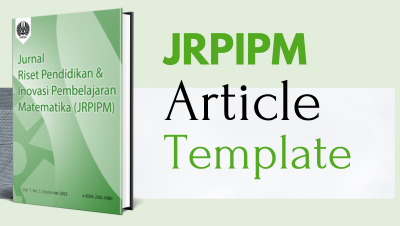Case Study: Exploration of Numeracy Through a Metacognitive Knowledge Approach
DOI:
https://doi.org/10.26740/jrpipm.v8n2.p182-196Keywords:
Case Study, Numeracy, Metacognitive, Metacognitive Knowledge, Cognitive regulation, MAIAbstract
This study explores students' numeracy literacy skills through a metacognitive approach with the Metacognitive Awareness Inventory (MAI) framework. Four female subjects were selected based on their highest scores on knowledge of cognition and regulation of cognition. Data were collected through problem-solving tests and in-depth interviews, analyzed based on six indicators of numeracy literacy: understanding the context of the problem, data interpretation, problem solving, reflection and reasoning, mathematical communication, and decision making. The results showed that regulation of cognition supported effective reflection and evaluation, as seen in Subject 3, who solved the problem in a structured and confident manner. In contrast, Subject 4 took longer and often hesitated even though her steps were correct. Subjects 1 and 2, with a focus on knowledge of cognition, excelled in choosing strategies but required additional reflection to ensure accuracy. This study emphasizes the importance of integrating numeracy literacy and metacognitive strategies in learning to improve students' critical and reflective abilities.
References
Agustan, S., Juniati, D., & Siswono, T. Y. E. (2017). Reflective thinking in solving an algebra problem: a case study of field independent-prospective teacher. Journal of Physics: Conference Series, 893, 012002. https://doi.org/10.1088/1742-6596/893/1/012002
Deeba, F., Malik, M. H., & Raza, M. A. (2022). Performance of Public and PEF School Students in Literacy and Numeracy Drive (LND): A Comparative Analysis. VFAST Transactions on Education and Social Sciences, 10, 142–148. https://www.researchgate.net/publication/361984928
Fiangga, S., M. Amin, S., Khabibah, S., Ekawati, R., & Rinda Prihartiwi, N. (2019). Penulisan Soal Literasi Numerasi bagi Guru SD di Kabupaten Ponorogo. Jurnal Anugerah, 1(1), 9–18. https://doi.org/10.31629/anugerah.v1i1.1631
Isnaintri, E., & Novaliyosi, N. (2024). Systematic literature study on numeracy literacy activities: How to implement it. Union: Jurnal Ilmiah Pendidikan Matematika, 12(1), 48–66. https://doi.org/10.30738/union.v12i1.16608
Laamena, C. M., & Laurens, T. (2021). Mathematical Literacy Ability and Metacognitive Characteristics Of Mathematics Pre-Service Teacher. Infinity Journal, 10(2), 259. https://doi.org/10.22460/infinity.v10i2.p259-270
Lestari, N. D. S., Juniati, D., & Suwarsono, St. (2018). Exploring the Knowledge of Content and Teaching (KCT) of prospective math teacher in planning mathematical literacy teaching. Journal of Physics: Conference Series, 1097, 012150. https://doi.org/10.1088/1742-6596/1097/1/012150
Musyafak, A., & Agoestanto, A. (2022). Pengembangan Bahan Ajar Statistika Bermuatan Soal Literasi Numerasi Bernuansa STEM untuk Meningkatkan Kemampuan Berpikir Kritis Peserta Didik pada PBL. Jurnal Tadris Matematika, 5(2), 273–284. https://doi.org/10.21274/jtm.2022.5.2.273-284
OECD. (2017). PISA 2015 Assessment and Analytical Framework. OECD. https://doi.org/10.1787/9789264281820-en
OECD. (2022). Trends Shaping Education 2022. OECD. https://doi.org/10.1787/6ae8771a-en
Pradika, I. D., Amin, S. M., & Khabibah, S. (2019). Relational Thinking in Problem Solving Mathematics based on Adversity Quotient and Visual Learning Style. International Journal of Trends in Mathematics Education Research, 2(4), 161–164. https://doi.org/10.33122/ijtmer.v2i4.61
Prenzel, M. , B. W. , & K. E. (2015). Assessing Mathematical Literacy (K. Stacey & R. Turner, Eds.). Springer International Publishing. https://doi.org/10.1007/978-3-319-10121-7
Rachmawati, R., Juniati, D., & Wintarti, A. (2022). Profil Berpikir Kritis Siswa Laki-Laki Maskulin dan Perempuan Feminin dalam Menyelesaikan Masalah Literasi Numerasi pada Asesmen Kompetensi Minimum. EDUKASIA: Jurnal Pendidikan dan Pembelajaran, 3(3), 927–936. https://doi.org/10.62775/edukasia.v3i3.218
Santoso, H. A., & Azizah, M. A. N. (2020). Scheme of Metacognitive Activities of FI-FD through Mathematical Representation. In Habiddin, E. H. Sanjaya, M. F. Marsuki, & N. C. E. Setiawan (Eds.), The 4th International Conference on Mathematics and Science Education (ICoMSE) 2020 (pp. 170–177). Faculty of Mathematics and Natural Sciences Universitas Negeri Malang.
Santoso, H. A., & Istiqomah, N. R. (2021). Constructive metacognition activities through students’ communication ability in solving PISA based on personality. Journal of Physics: Conference Series, 1747(1), 012043. https://doi.org/10.1088/1742-6596/1747/1/012043
Santoso, H. A., Rahadjo, S., & Sholiha, U. H. (2021). Designing slow learners’ metacognition activities through communication ability based on multiple intelligence. AIP Conference Proceedings, 2330. https://doi.org/10.1063/5.0044062
Schraw, G., & Moshman, D. (1995). Metacognitive theories. Educational Psychology Review, 7(4), 351–371. https://doi.org/10.1007/BF02212307
Shodikin, A., Nurkumala, S. E., & Sumarno, W. K. (2022). Student Metacognition in Mathematics Problem Solving on Set Materials. Mathline: Jurnal Matematika Dan Pendidikan Matematika, 7(2), 288-297. https://doi.org/10.31943/mathline.v7i2.297
Siagian, M. V., Saragih, S., & Sinaga, B. (2019). Development of Learning Materials Oriented on Problem-Based Learning Model to Improve Students’ Mathematical Problem Solving Ability and Metacognition Ability. International Electronic Journal of Mathematics Education, 14(2). https://doi.org/10.29333/iejme/5717
Sitompul, R. S. I., Budayasa, I. K., & Masriyah. (2018). Mathematics Literacy of Secondary Students in Solving Simultanenous Linear Equations. Journal of Physics: Conference Series, 947, 012019. https://doi.org/10.1088/1742-6596/947/1/012019
Sumarno, W. K., Kusumaningrum, W. R., & Nurhayati, E. (2021). The effects of knowledge and regulation of cognition on the students’ writing skills in a metacognitive process-oriented writing instruction. Journal of Language and Linguistic Studies, 18(1), 523-536. https://www.jlls.org/index.php/jlls/article/view/2844/987
Sumarno, W. K., Shodikin, A., Solikha, N. I., Pratama, N. K., & Valensiana, B. F. (2022). Integrative Teaching Material with Project-based Learning Approach to Improve Elementary School Students’ Bilingual Literacy and Numeracy Skills. International Journal of Elementary Education, 6(4), 600–611. https://doi.org/10.23887/ijee.v6i4.52392
Sumarno, W. K., Riyantoko, P. A., & Shodikin, A. (2024). Effectiveness of Bilingual Project-Based Materials to Facilitate Literacy and Numeracy Teaching. TEM Journal, 13(1), 68-76. http://doi.org/10.18421/TEM131-07
Syamsuddin, A., Juniati, D., & Siswono, T. Y. E. (2020). Understanding the Problem Solving Strategy Based on Cognitive Style as a Tool to Investigate Reflective Thinking Process of Prospective Teacher. Universal Journal of Educational Research, 8(6), 2614–2620. https://doi.org/10.13189/ujer.2020.080644
Tran, L. T., Wardle, H., Colledge-Frisby, S., Taylor, S., Lynch, M., Rehm, J., Volberg, R., Marionneau, V., Saxena, S., Bunn, C., Farrell, M., & Degenhardt, L. (2024). The prevalence of gambling and problematic gambling: a systematic review and meta-analysis. The Lancet Public Health, 9(8), e594–e613. https://doi.org/10.1016/S2468-2667(24)00126-9
Trisna, B. N., Budayasa, I. K., & Siswono, T. Y. E. (2018). Students’ metacognitive activities in solving the combinatorics problem: the experience of students with holist-serialist cognitive style. Journal of Physics: Conference Series, 947, 012072. https://doi.org/10.1088/1742-6596/947/1/012072
Yustitia, V., Siswono, T. Y. E., & Abadi. (2021). Numeracy of prospective elementary school teachers: a case study. Journal of Physics: Conference Series, 1918(4), 042077. https://doi.org/10.1088/1742-6596/1918/4/042077
Downloads
Published
How to Cite
Issue
Section
 Abstract views: 29
,
Abstract views: 29
, PDF Downloads: 51
PDF Downloads: 51






